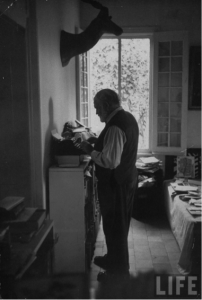
In an 1883 article from Popular Science, Dr. Felix Oswald expounds on the remedies of nature. Mingled with imperatives about taking cold baths before dinner and opening bedroom windows at night is this pearl: “At the first symptoms of indigestion, book-keepers, entry-clerks, authors, and editors should get a telescope-desk. Literary occupations need not necessarily involve sedentary habits, though, as the alternative of a standing-desk, I should prefer a Turkish writing-tablet and a square yard of carpet-cloth to squat upon.”
The Turkish writing tablet never quite took off, but the standing desk, over a century later, has entered its heyday. It’s changing the cubicle skyline of corporate America, the open-plan shared workspaces of the startup world, and the studios and work nooks of thousands of writers across the country.
Facebook reportedly has about 350 standing desks, with another 10-15 requests coming in each week from employees. The desk manufacturer Steelcase began selling height-adjustable desks in 2004. Since then, sales have increased fivefold. Its clients include Apple, Google, Intel, Boeing, and Allstate.
As a novelist with a day job in the high-tech world, I see standing desks popping up all around me. They range from jerrybuilt towers of books with balanced flat-screen monitors to ergonomic masterpieces with whisper-quiet hydraulic systems. A friend of mine who writes for Rolling Stone stacks several reams of paper on his conventional desk and perches his laptop there. My boss, a digital marketing director who’s a little under five feet tall and comes to work in heels, has a sleek model from Varidesk and an inch of cushioning foam at her feet. She spends most of her days sitting in meetings, so she relishes the forays back to her desk to check emails. She claims that standing helps her concentrate and sleep better at night.
According to recent studies, the health risks of sitting for prolonged periods of time are significant. After an hour of sitting, the production of enzymes that burn fat in the body decline by as much as 90 percent, thereby slowing overall metabolism. Interestingly, while the scientific data around the perils of sitting is better today than it was in 1883, the year of the Popular Science article, the reason people stand to work are largely the same — they feel more energized and compelled by the task in front of them, whether it’s editing a novel or a spreadsheet.

For writers, the standing desk has a long and prestigious lineage. It’s often seen as a workhorse of productivity and inspiration. Great novels and speeches, treaties and philosophical tracts, have all been written at the height of the sternum. Kierkegard, Dickens, Hemingway, Woolf, Nabokov, Churchill, and Thomas Jefferson all used them. Though, to be fair, they weren’t always faithful to their tall desks. Churchill sometimes liked to lie in bed, propped up on pillows, when he was working on a speech or manuscript. And Jefferson liked to use a lap desk on occasion. But it’s hard to imagine either politician producing their most muscular prose while reclining. Surely “We shall fight on the beaches” and the original draft of the Declaration of Independence were written from behind slanting, adjustable desktops. Jefferson’s standing desk even had two extra legs to keep him anchored during his mental heights.
Mrs. Dalloway was written at a standing desk. So was David Copperfield. The 19th-century novelist Elizabeth Gaskell noted the layout of Dickens’s study: “…books all round, up to the ceiling and down to the ground; a standing-desk at which he writes; and all manner of comfortable easy chairs.” In the 20th century, Quentin Bell, Woolf’s nephew and biographer, wrote that she “had a desk standing about three feet six inches high with a sloping top; it was so high that she had to stand at her work.” It’s often said that Woolf treated an emerging manuscript like a painter’s canvas, that she liked to step away from the work to consider it from new angles.

Hemingway’s standing desk was perhaps the crudest of them all — a set of bookshelves with a typewriter perched on top.
In a 1954 Paris Review interview with Hemingway, George Plimpton begins by describing the writer’s workspace in Cuba:
“He has a special workroom prepared for him in a square tower at the southwest corner of the house, but prefers to work in his bedroom, climbing to the tower room only when “characters” drive him up there…The room is divided into two alcoves by a pair of chest-high bookcases that stand out into the room at right angles from opposite walls…It is on the top of one of these cluttered bookcases — the one against the wall by the east window and three feet or so from his bed — that Hemingway has his “work desk”—a square foot of cramped area hemmed in by books on one side and on the other by a newspaper-covered heap of papers, manuscripts, and pamphlets.”
Nabokov, like Churchill and Jefferson, knew the value of standing to write, but he also knew when to sit down. In Brian Boyd’s Vladimir Nabokov: The American Years the famous writer’s afternoon routine is delineated:
“Nabokov would be back at his desk by one-thirty and work steadily until six-thirty. Normally he would have started the day in ‘the vertical position of vertebrate thought,’ standing ‘at a lovely old-fashioned lectern I have in my study. Later on, when I feel gravity nibbling at my calves, I settle down in a comfortable armchair alongside an ordinary writing desk; and finally, when gravity begins climbing up my spin, I lie down on a couch in a corner of my small study.”
Philip Roth also uses a lectern, at least he did until he publically announced that he was retiring from writing. In the documentary Philip Roth: Unmasked, we see the writer at his standing desk — one at his Connecticut hideaway in the woods and another in his Upper West Side work studio. The lectern is kept at right angles to the view, presumably to avoid distraction. Roth has said that he paces about half a mile for every page he writes.

Despite the undeniable health benefits and the pedigree of the standing desk, there’s something about the seated desk that’s hard to give up. For one thing, it has deeper drawers and recesses for hoarding stationery and curios. The Harry Ransom Center in Austin, Texas, has collected a number of famous desks over the years, including ones that belonged to Edgar Allan Poe, Compton MacKenzie, and John Fowles. In 2008, when John Fowles’s widow shipped her husband’s archive and desk to the Ransom Center, she left the entire contents of the desk intact. For sheer variety, it’s hard to beat what’s tucked inside the Fowles’s much-loved desk, its left drawer marked with scrawled addresses and phone numbers in the author’s hand.
Newspaper clippings
A set of blue labels with white string ties
A box of staples
Old photographs
A Richards Sheffield pocketknife
Four pairs of eyeglasses
An envelope of dried seeds
Two canisters containing typewriter ribbons
A tin of pastels
A paper fan
Swedish and Greek coins
A leather dice shaker
A pair of medical scissors
Two pipes
A set of brass knuckles
The list goes on. For every five practical items, like a box of staples, there is something enigmatic, like the set of brass knuckles. Given that fiction involves the careful selection of details that are concrete, sensory, and significant, Fowles’s desk is a microcosm of the writing enterprise itself. It contains worlds.
The standing desk, on the other hand, is less capacious and sentimental. There’s very little room to store abandoned manuscripts, rejection letters, or knickknacks. Distractions are kept to a minimum. It’s taller, sleeker, and less hospitable than its slouchier cousin. In the way that it mimics a lectern, a podium, or a drafting table, it reminds the writer that this activity requires blood, enzymes, and exertion. Here is your novel, spread out like a map or a campaign speech. Here are your poems, arranged like blueprints. Pace, stamp your feet, fold your arms, but stay upright. Stand there like it’s the prow of a ship.








